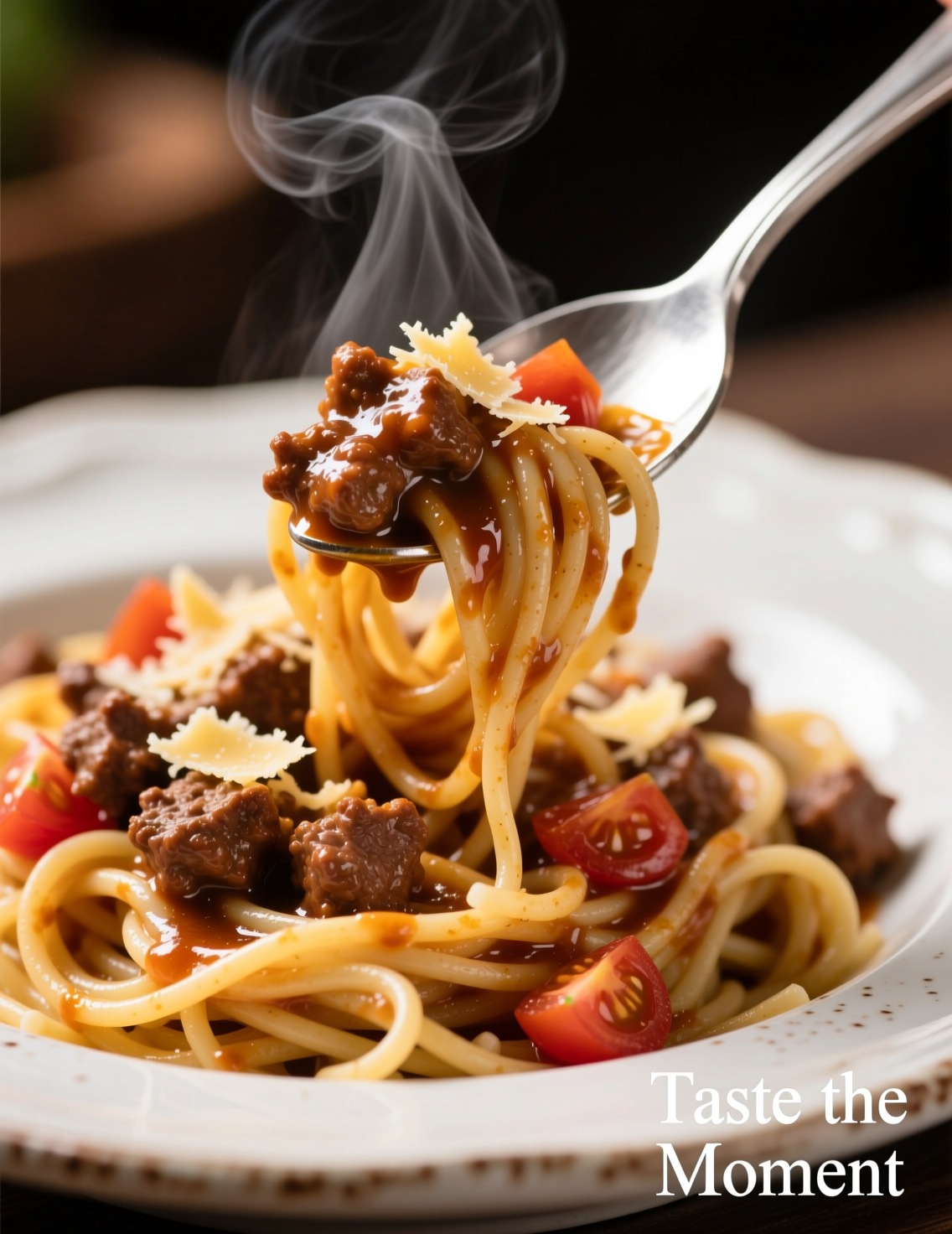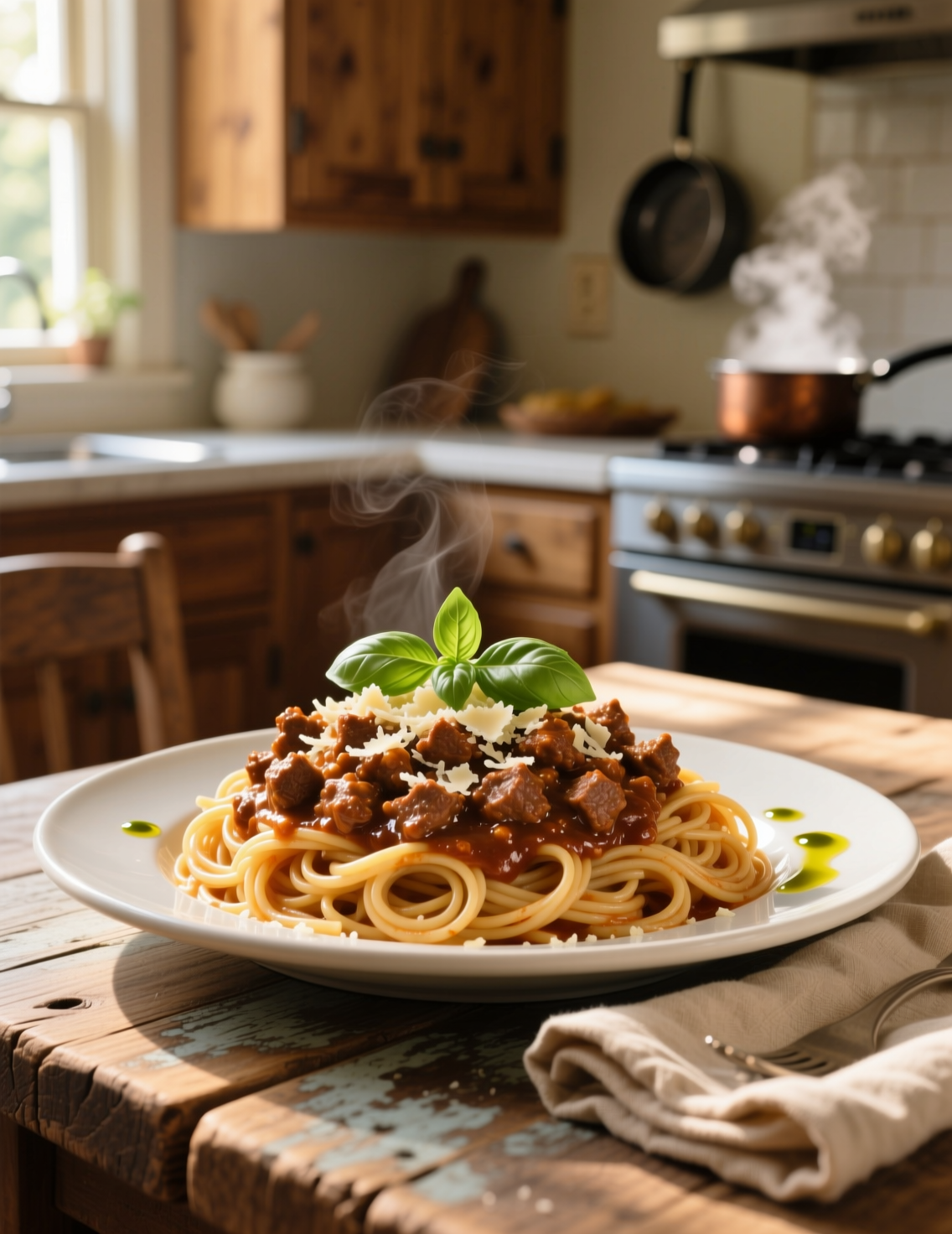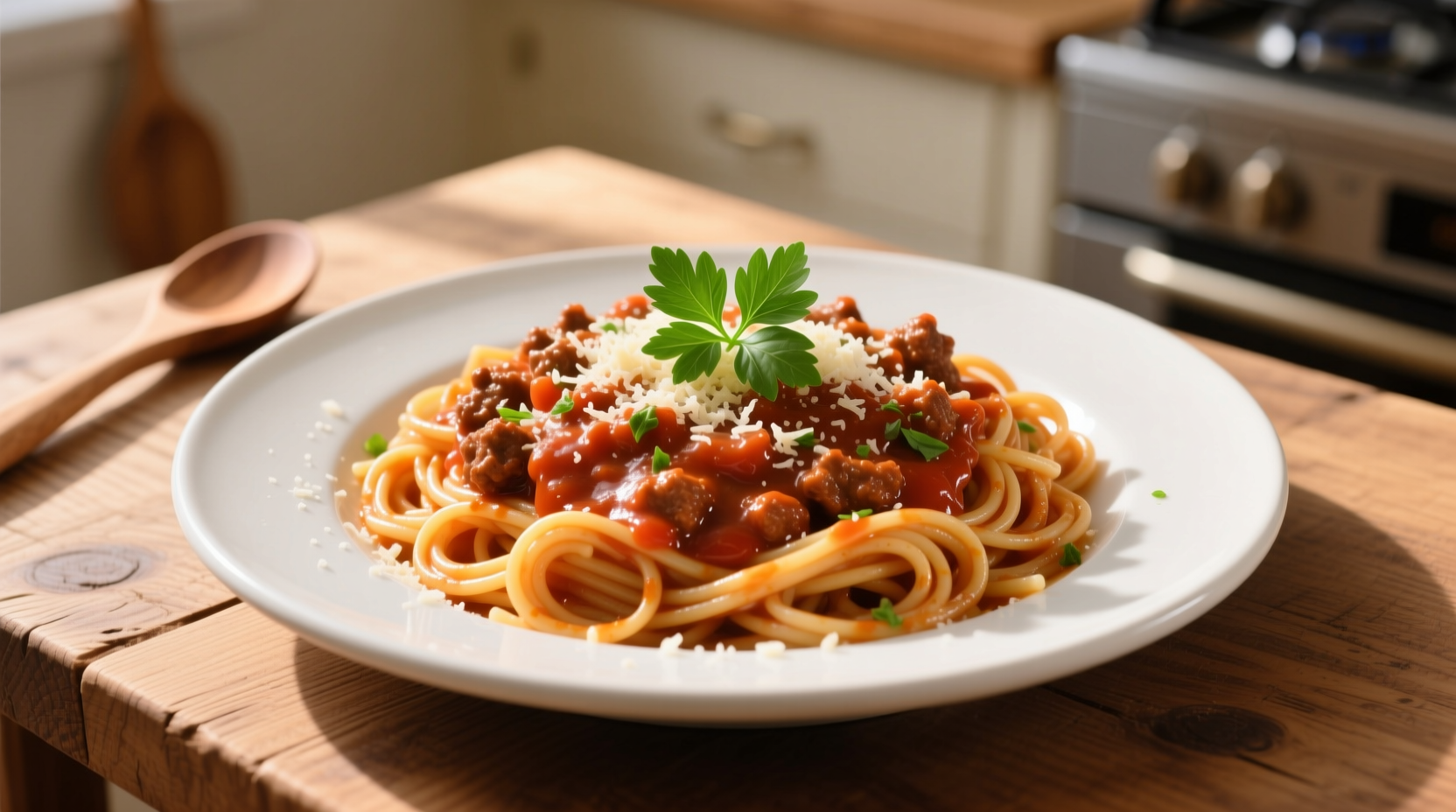Few dishes carry the kind of comfort and culinary satisfaction that a classic spaghetti with meat sauce offers. This recipe, crafted for four servings, isn’t just about tossing noodles and sauce together. It’s a study in layering flavors, textures, and techniques that can elevate a home meal to something restaurant-worthy. If you’ve ever wondered what makes some meat sauces taste deeper, richer, and somehow more “homemade,” you’re about to get the full inside scoop.
Why This Spaghetti and Meat Sauce Stands Out
Many cooks think spaghetti is simple. Toss pasta in sauce, done. But the magic is in the details. A truly hearty sauce balances sweetness, acidity, umami, and aromatics. Studies in culinary science show that slow-simmered sauces allow Maillard reaction flavors from browned meat to dissolve into the sauce, creating complex, layered tastes. Even a few small tweaks—like using half beef, half pork—can change the mouthfeel dramatically. You’re not just making dinner. You’re sculpting flavor.
Ingredients Matter More Than You Think
For 4 servings, here’s what you’ll need:
- 12 ounces of dry spaghetti
- 1 pound of ground beef (85% lean)
- 1/2 pound of ground pork
- 1 medium onion, finely diced
- 3 cloves garlic, minced
- 1 28-ounce can crushed tomatoes
- 2 tablespoons tomato paste
- 1 teaspoon sugar (balances acidity)
- 1 teaspoon dried oregano
- 1 teaspoon dried basil
- 1/2 teaspoon crushed red pepper flakes
- Salt and freshly cracked black pepper to taste
- 2 tablespoons olive oil
- 1/4 cup red wine (optional but recommended)
- Fresh parsley or basil for garnish
- Grated Parmesan cheese to serve
Each ingredient contributes to the final symphony of flavors. Ground pork adds fat and silkiness. Tomato paste intensifies umami without turning the sauce bitter. Red wine gives acidity and a subtle depth most novices skip.

Technique: Browning Meat Like a Pro
Browning your meat properly is where the pro edge comes in. Many cooks just toss meat in a pan. Wrong. Meat needs contact with a hot surface to caramelize. Don’t overcrowd the pan; do it in batches. The Maillard reaction isn’t just a buzzword—it’s why your sauce will taste deep, savory, and rich. Once browned, remove the meat, keep the drippings. They’re liquid gold.
Building Layers with Aromatics
In the same pan, add olive oil if needed, then onions. Sweat them gently, don’t let them burn. Add garlic near the end; garlic can turn bitter if sautéed too long. This stage builds your base. Toss in your herbs—dried oregano, basil, and crushed red pepper. Herbs release oils that penetrate the sauce during simmering. Smell it. That smell? That’s flavor building.
Deglazing and Adding Tomatoes
Deglazing is a term that scares some beginners, but it’s simple. Pour red wine into the hot pan. Scrape up all those brown bits. Every scrap clinging to the pan carries concentrated flavor. After the wine reduces slightly, add crushed tomatoes and tomato paste. Stir well. This combination makes a sauce that clings to spaghetti instead of sliding off like watery soup.
Simmering Secrets
Here’s where many people fail: rushing. You need at least 30–40 minutes of gentle simmer. Lid partially on. Stir occasionally. The longer it cooks, the more the flavors meld. Some chefs add a splash of water or stock if it reduces too much, keeping consistency balanced. The sugar isn’t just for taste—it neutralizes tomato acidity subtly, giving a rounder profile.
Perfecting Spaghetti Cooking
Spaghetti is simple, yet mistakes are common. Boil in plenty of salted water—like the sea, not a pond. Salt seasons pasta internally. Cook until just al dente. Yes, you’ll finish cooking with the sauce. This prevents mushiness and helps the sauce adhere. Remember: spaghetti is not just a carrier; it’s part of the flavor architecture.
Marrying Pasta and Sauce
Combine pasta and sauce in the pan over low heat. Toss gently, coating every strand. This step is crucial; it’s where starch meets sauce and creates a silky finish. Finish with a drizzle of olive oil and a sprinkle of Parmesan. Fresh herbs? Non-negotiable. They give color and a fresh note that brightens the rich meatiness.
Pro Tips for an Elevated Meat Sauce
- Use a mix of meats: Combining beef and pork or veal adds layers.
- Don’t skip wine: Even a splash transforms flavor; cook alcohol off.
- Simmer low and slow: Patience creates depth.
- Add a touch of dairy: A teaspoon of cream or butter at the end softens acidity and enriches mouthfeel.
- Texture matters: Some prefer chunky sauce; others fine. Chop meat coarsely for rustic appeal.
Common Misconceptions
Many think tomato sauce needs sugar in huge amounts. Wrong. A teaspoon balances acidity; overdo it, and the sauce tastes like candy. Another myth: higher heat = faster flavor. No, medium-low simmer extracts flavor, not boiling. Lastly, canned tomatoes aren’t inferior. Choose quality, and you’ll rarely taste a difference from fresh, especially out of season.
Nutritional Insights
A serving of hearty spaghetti and meat sauce packs approximately:
- Calories: 550–600
- Protein: 28–32g
- Fat: 20–25g
- Carbs: 60–65g
This makes it a balanced meal for energy and satiety. Pairing with a simple salad adds fiber and micronutrients without overwhelming the palate. For professional kitchens, portioning precisely ensures consistency, critical for repeat customers or meal prep services.
Emerging Trends and Variations
Chefs are experimenting with:
- Plant-forward options: Lentils or mushrooms replace half the meat for lower carbon footprint.
- International twists: Adding miso, Worcestershire, or smoked paprika gives nuanced umami.
- Texture layering: Roasted cherry tomatoes or caramelized onions for added complexity.
Even subtle tweaks transform a classic dish into signature menu items that diners remember.

Serving Suggestions
Serve immediately with freshly grated Parmesan. A drizzle of good olive oil and a few basil leaves elevate presentation. Pair with crisp white wine or sparkling water. For families, add a side of garlic bread or roasted vegetables for a complete comfort meal. Remember, plating isn’t just aesthetics; it signals care, even in casual dining.
Expert Insights from the Field
Professional chefs often repeat one mantra: sauce builds flavor. They invest time in every stage, from meat browning to final toss. Observational studies in culinary schools show that students who skipped slow simmering scored sauces lower in taste tests, even with high-quality ingredients. Small details, like timing garlic addition or degreasing excess fat, separate an “okay” spaghetti from an unforgettable one.
Troubleshooting Common Issues
- Watery sauce: Simmer uncovered to reduce. Add tomato paste for thickness.
- Bitter taste: Garlic burnt or canned tomato too acidic. Balance with sugar or butter.
- Meat clumps: Brown in batches and break apart during cooking.
- Overcooked pasta: Finish cooking in sauce for proper texture.
Even experienced cooks sometimes slip. Understanding why the sauce misbehaves is the first step to mastery.
Final Thoughts
This hearty spaghetti and meat sauce recipe isn’t just food; it’s a lesson in patience, technique, and flavor science. Using quality ingredients, proper browning, and careful simmering results in a dish that’s rich, comforting, and deeply satisfying. It’s perfect for family dinners, meal prep, or impressing guests. Remember: cooking is part technique, part instinct. Trust your nose, taste frequently, and adjust along the way.
In conclusion, mastering spaghetti and meat sauce for four servings means respecting each ingredient, layer, and technique. From browning meat to simmering sauce slowly, each step contributes to a balanced, flavorful final dish. Whether you’re feeding family or training kitchen staff, the principles remain the same: patience, attention, and an unwavering focus on flavor.
FAQs
What type of meat is best for this spaghetti and meat sauce?
A mix of ground beef and pork gives the richest flavor and texture.
How long should the sauce simmer?
At least 30–40 minutes on low heat for full flavor development.
Can I use only one type of meat?
Yes, but mixing meats adds more depth and silkiness.
Do I need to add sugar to the sauce?
Just a teaspoon helps balance tomato acidity without making it sweet.
Can I skip the red wine?
Yes, but wine adds subtle acidity and deeper flavor.
How should I cook the spaghetti?
Boil in plenty of salted water until just al dente.
When should I add garlic to the sauce?
Near the end of sautéing onions to avoid bitterness.
How do I thicken a watery sauce?
Simmer uncovered or stir in extra tomato paste.
Can I make this sauce ahead of time?
Yes, it tastes even better the next day after flavors meld.
What’s the best way to serve this dish?
Toss pasta in sauce, top with fresh herbs and Parmesan.
Can I make a vegetarian version?
Yes, replace half the meat with lentils or mushrooms.
How do I prevent overcooked pasta?
Finish cooking the pasta in the sauce to absorb flavor and stay firm.
Is fresh tomato better than canned?
High-quality canned tomatoes work best year-round and are consistent.
Can I add extra vegetables?
Absolutely—carrots, bell peppers, or mushrooms enhance flavor and nutrition.
What wine pairs well with this meal?
Medium-bodied reds like Chianti or Merlot complement the sauce perfectly.

Mariana is a passionate home cook who creates delicious, easy-to-follow recipes for busy people. From energizing breakfasts to satisfying dinners and indulgent desserts, her dishes are designed to fuel both your body and hustle.
When she’s not in the kitchen, she’s exploring new flavors and dreaming up her next recipe to share with the Foodie Hustle community.

